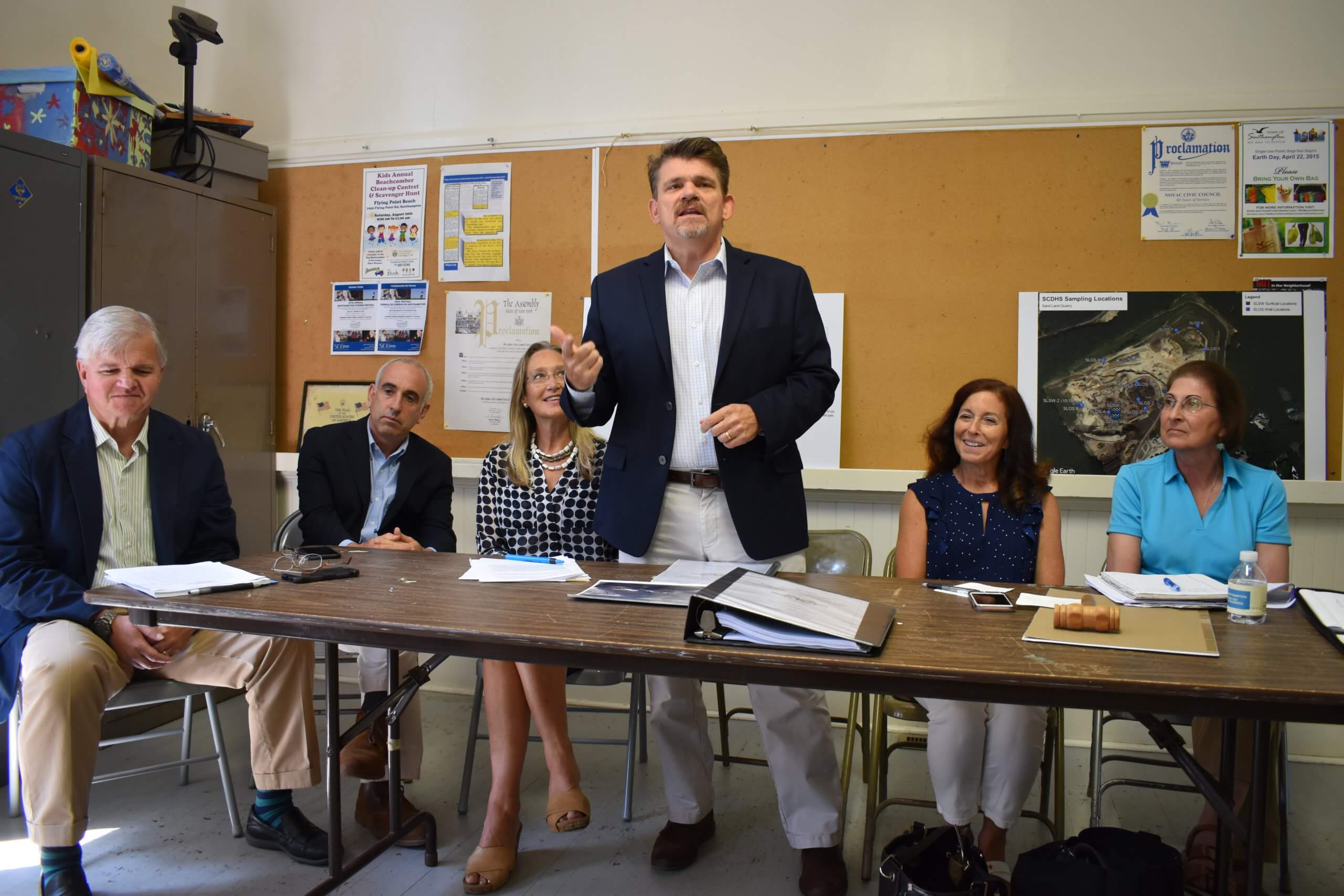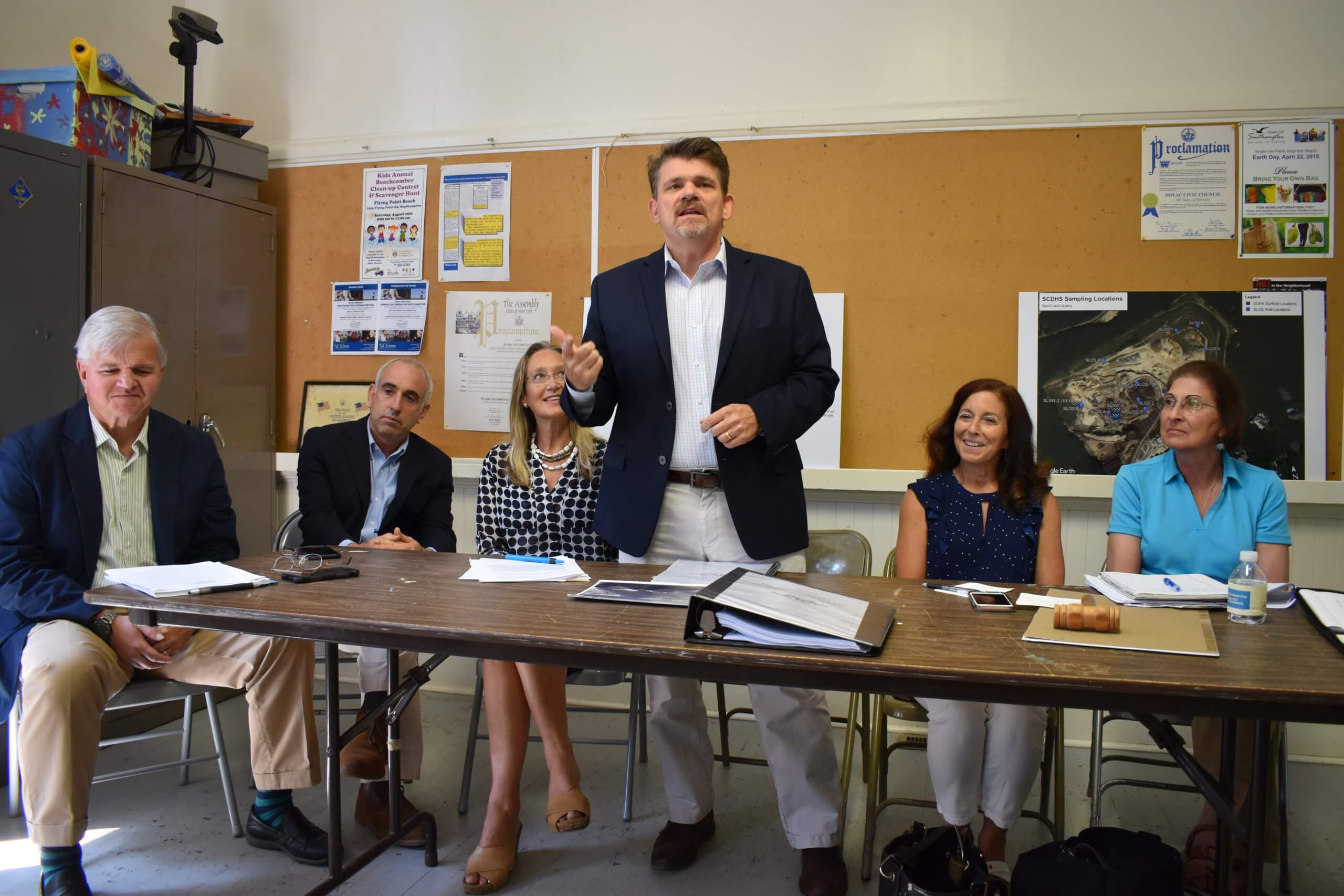Call For Sand Land Closure


Southampton Town Councilman Tommy John Schiavoni speaks at a press conference on Friday, calling for the closing of the Sand Land mulching site in Noyac. With him are, left to right, Assemblyman Fred Thiele, Southampton Town Supervisor Jay Schneiderman, County Legislator Bridget Fleming, Adrienne Esposito, executive director of the Citizens Campaign for the Environment, and Elena Loreto, president of the Noyac Civic Council.
Noyac residents were joined by environmentalists and elected officials on Friday, July 13, to call for the closure of Sand Land, a one-time sand mine that is now a vegetative waste processing facility. A recent report from the Suffolk County Department of Health Services concluded it is polluting the groundwater.
“We want our officials to act now before this becomes a Superfund site,” said Elena Loreto, the president of the Noyac Civic Council, which has been fighting to close Sand Land for years. “We don’t have time to let our aquifer become polluted.”
“The word is desperate, the word is anxious, the word is exasperated,” she added, as she described how neighbors feel about the situation. “We cannot wait any longer.”
Earlier this month, the health department released a study showing highly elevated levels of metals such as manganese and iron and other chemicals and pollutants, including nitrogen, in 20 test wells that were drilled at the 50-acre Sand Land site off Millstone Road.
Current Southampton Supervisor Jay Schneiderman received county backing for the testing in 2015 when he was a county legislator. Sand Land’s owners fought in court to prevent the county from gaining access to the property, but lost that battle and the testing finally began in 2017.
Robert DeLuca, president of the Group for the East End, said the county’s findings were particularly disturbing, given the location of the old mine in a special groundwater protection area. “What the county expected to find there, sadly, they found there, based on similar studies elsewhere,” he said. Studies have found that metals, like manganese, which was found at levels 100 times the health threshold, are unlocked during the mulching process.
DeLuca said the county’s tests found that the contaminants were found at deep levels. “They believe it has moved deep into the aquifer,” he said, noting that the problem is serious enough the county wants to continue to test private wells around the site.
Sand Land has sought an expansion of its sand-mining permit from the New York State Department of Environmental Conservation. A provision in the state law overseeing sand mines gives the town authority to weigh in.
“This is sad. This is nothing to celebrate, this report,” said Schneiderman, who insisted the town has done everything in its power to bring the operation to heel, but that its efforts have been sidetracked by the slow process of the legal system.
A town Zoning Board of Appeals ruling denied Sand Land the right to process and reclaim construction and demolition debris or process and sell yard waste, like leaves and brush, and he said the town has done everything from issuing tickets to businesses using the site to seeking a court injunction to force Sand Land to close.
He said he would soon be sending letter to the DEC informing it that sand mines are no longer legal in the town. “There is no place to have a mine in the town. End of story,” he said. “As far as I’m concerned, it’s over.”
Although the DEC had requested that Schneiderman weigh in back in March, he said the letter had been delayed, pending continued legal wrangling over the mining permit application.
Councilman Tommy John Schiavoni said that Sand Land’s DEC permits expire in November and that the town was committed to protecting the aquifer and suggested the town may try to acquire the site. “We are going to reclaim that mine for the public use, for the public good,” he said, adding, in reference to the health department report, “We have our marching orders here.”
In the meantime, Suffolk County Legislator Bridget Fleming said it was essential that everyone living in the area outlined by the health department have their wells tested. “Folks need to be reassured that their drinking water supply is safe,” she said. “The only source of drinking water we have is right below our feet.”
“We don’t see numbers like these,” Assemblyman Fred Thiele said of the report. “It’s not just the concentration of these chemicals and the number of them, it is also the depth in the groundwater table they are finding them, 137 to 154 feet.” He said the chemicals had reached the deepest part of the aquifer and could be spreading off site.
Although Sand Land’s attorneys have questioned the accuracy of the county’s findings, Thiele said of the health department, “when it comes to doing these investigations . . . they are the platinum standard.”
Brian Matthews, Sand Land’s attorney, said on Tuesday the firm had questions about the county’s report. “All indications are that it was flawed, inadequate, and based on conclusions that were frankly predetermined,” he said.
He questioned the town’s sharp focus on the Sand Land site when the town itself conducts similar composting operations at its North Sea, Hampton Bays, and Westhampton transfer stations.
sjkotz@indyeastend.com



